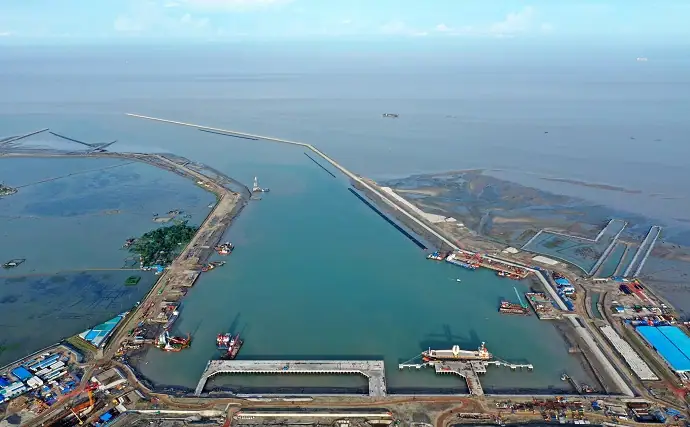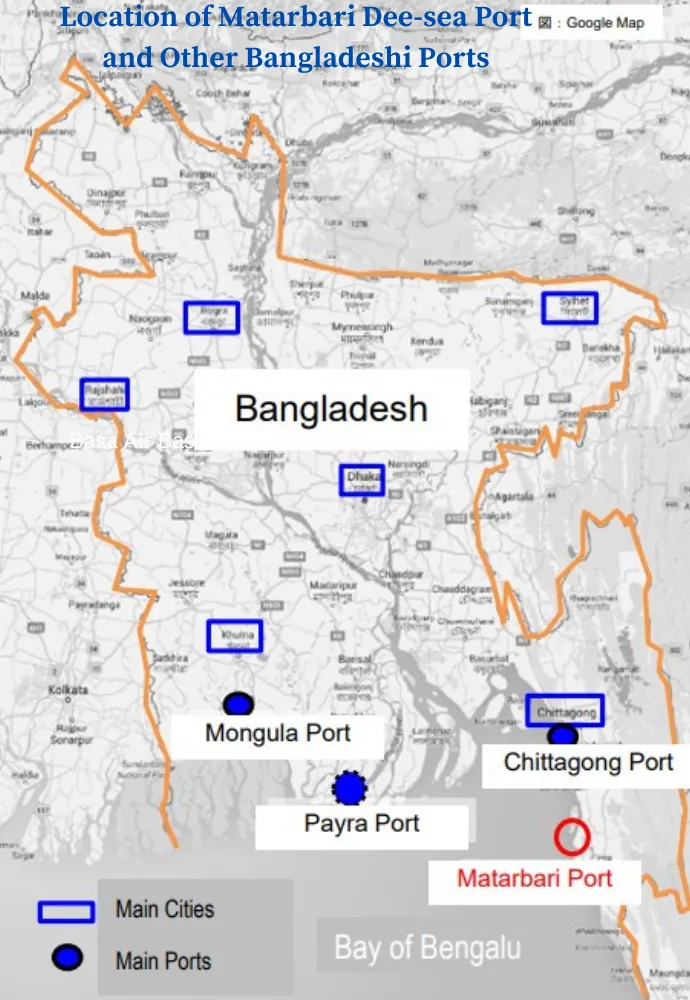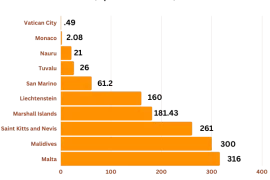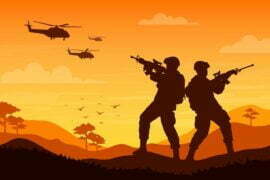Bangladesh, in collaboration with Japan, is currently constructing its first deep-sea port at Matarbari in Cox’s Bazar. The significance of the Matarbari Deep-sea Port goes beyond economic gains for Bangladesh. It holds the potential to become a regional gateway for landlocked neighbouring areas such as Nepal, Bhutan, and Northeast India. Additionally, its strategic location in the Bay of Bengal positions it as a focal point of geopolitical competition among major powers operating in the Indian Ocean.
The interim government, led by Dr. Yunus, has extended the project’s completion date to December 2029. Full commercial operations are expected by 2030. The cost will increase by Tk 65.73 billion, which is about 37 percent more than the original estimate. The initial budget was Tk 177 billion, set by the Awami League government. The original completion date was December 31, 2026. The Japan International Cooperation Agency (JICA) will provide the additional funds as a loan.
Bangladesh’s Quest for a Deep-sea Port
Bangladesh has three ports, namely Chittagong Port, Payra Port and Mongla Port. But these ports can’t handle deep-sea vessels, which hinders the docking of large ships carrying export or import cargo.
Presently, large ships destined for Bangladesh have to dock at transshipment hubs in countries like Sri Lanka and Singapore, and then transfer cargo onto smaller vessels to reach Bangladesh’s ports. This arrangement incurs higher trading costs, delays, and dependence on neighboring countries’ infrastructure.
Establishing a deep-sea port within Bangladesh would not only reduce these costs and facilitate trade, but also position the country as a potential regional transshipment hub. Bangladesh envisions that this port could attract numerous nations in South Asia, including landlocked countries like Nepal and Bhutan, as well as regions in north-eastern India, southern China, and Myanmar, to fulfill their cargo shipment requirements.
Bangladesh has been considering the construction of a deep-sea port for quite some time as a strategic solution to cater to its growing trade needs.
In 2004, the BNP-led four-party alliance government in Bangladesh took proactive steps to establish a deep-sea port at a strategic location within the country. To carry out the preliminary groundwork for the project, the government engaged the expertise of Pacific Consultants International (PCI), a renowned Japanese firm, in August 2006.
Sonadia Deep-sea Port Porject
In July 2007, Bangladesh Shipping Ministry along with PCI proposed Sonadia Island, a 9 sq km offshore Cox’s Bazar, as a suitable location for a deep-sea port.
In 2009, Sonadia Island in Cox’s Bazar district was finalized as the suitable location for constructing a deep-sea port after a feasibility assessment.
China stepped forward to provide assistance, submitting a detailed project proposal and loan plan to cover a significant portion of the project cost during Prime Minister Sheikh Hasina’s visit to Beijing in 2014.
China Harbour Engineering Company, a subsidiary of the state-owned China Communications Construction Company and also involved in building the Colombo Port in Sri Lanka, was selected as the contractor for the project. Despite high anticipation for a deal during Chinese President Xi Jinping’s visit to Dhaka in 2016, no progress was made.
Ultimately, in August 2020, the Hasina government officially announced the cancellation of the deep-sea port project during a cabinet meeting. Cabinet Secretary Khandker Anwarul Islam informed reporters that the cancellation was due to environmental concerns, as the construction of a deep-sea port on Sonadia Island could potentially cause severe damage to local biodiversity.
India, Japan, and the U.S., who are wary of China’s increasing presence in the Indian Ocean, were reported to have exerted pressure on Bangladesh to reject the project.
Payra Deep-sea Port Project
The government then made the decision to establish a deep-sea port at Payra in Patuakhali instead of Sonadia. Significant investments were made for this purpose. However, the substantial costs associated with dredging the 70km channel area on an annual basis, lead to a reconsideration of the viability of Payra as a location for the deep-sea port.
Matarbari Deep-sea Port
On March 10, 2020, the Executive Committee of the National Economic Council of the Government of Bangladesh gave its approval for the Matarbari Deep-sea Port to be established as the country’s first-ever deep-sea project. Matarbari is 25 kilometers away from Sonadia. The port was originally conceived for the purpose of facilitating the import of coal and equipment for the 1200MW coal-fired power plant, and the Matarbari coal-fired power plant project received approval at the ECNEC meeting in 2014.
The estimated cost of the Matarbari deep-sea project is Tk 177.77 billion, with JICA expected to provide Tk 128.93 billion in funding, while the Bangladesh government and the Chittagong Port Authority, the designated implementing agency, will contribute a total of Tk 48.84 billion.
As per sources in the planning commission, Prothom Alo reported that the decision to transform Matarbari Port into a deep-sea port has resulted in significant changes. The length of the port increased from 3km to 14.3km, the breadth of the channel widened from 250 meters to 350 meters, and the depth increased from 15 meters to 18.5 meters. Additionally, six more jetties will be there, bringing the total number of jetties at Matarbari Port to eight. The new design of the port has been finalized based on studies conducted by reputable companies such as Japan’s Koei, Germany’s Pichner, Japan’s TEPSCO, Australia’s SMEC, and others.
Moheshkhali and Matarbari Integrated Infrastructure Development Initiative (MIDI)
The Matarbari Port holds a central and vital role in the Moheshkhali and Matarbari Integrated Infrastructure Development Initiative (MIDI), a collaborative effort between Bangladesh and Japan.
On March 29, 2023, the Government of Bangladesh and JICA signed Loan Agreements in Dhaka, marking a significant milestone for three key projects. These projects include the Matarbari Port Development Project (II), the Chattogram-Cox’s Bazar Highway Improvement Project (I), and the Project for the Construction of Dual Gauge Double Line between Joydebpur-Ishurdi Section (E/S). The total amount of Japanese ODA loans extended for these projects is up to 165.319 billion yen (equivalent to Tk 13,000 crore).
The Chattogram-Cox’s Bazar Highway Improvement Project has a close link to MIDI and will ensure a smooth and efficient transportation route to connect with the Matarbari Deep Sea Port.

Key Features of the Matarbari Deep-sea Port
- Matarbari Port is the first deep-sea port in Bangladesh.
- Matarbari Port is modeled after the Japanese ports of Kashima and Niigata.
- Matarbari Port will be operational in December, 2029.
- Matarbari Port will have two terminals: one is 300 meters long and the other is 460 meters long.
- The estimated cost of the Matarbari Port project is Tk 243.81 billion
The Strategic Location of Matarbari
The strategic location of the Matarbari Deep-sea Port in Bangladesh holds immense significance, not only for Bangladesh but also for major powers such as China, India, and the United States, due to the unique advantages it offers.
One of the key factors contributing to the strategic importance of the Matarbari port is its proximity to the Bay of Bengal, which is a critical maritime trade route. As mentioned, a quarter of the world’s traded goods, including substantial volumes of Persian Gulf oil and liquefied natural gas, pass through the Bay of Bengal. This makes the Matarbari port an ideal location for transshipment and trade activities, as it provides a gateway for global shipping lines to access the Bay of Bengal and beyond.
Moreover, the Bay of Bengal has abundant natural resources, including untapped reserves of oil, gas, and minerals, as well as fishing stocks. The Matarbari port’s strategic location presents opportunities for potential extraction and utilization of these resources, attracting interest from major powers seeking to secure access to these valuable assets.
Furthermore, the northeastern part of the Indian Ocean, which includes the Bay of Bengal, has been witnessing growing strategic interest from countries like China, India, and the United States. These countries are keen on establishing a strong presence in the region due to its geostrategic significance, including its proximity to vital sea lanes, potential for resource exploration, and geopolitical considerations.
Bangladesh’s Vision for the Matarbari Port
The volume of imports and exports through Bangladesh’s ports amounts to approximately USD 60 billion annually.
According to statistics from the Chattogram Port Authority (CPA), ship arrivals at the ports are increasing by over 11% each year. However, due to the insufficient depth and breadth of the Karnaphuli channel, ships larger than 190 meters in length and 9.5 meters in draft cannot anchor at the Chattogram port jetty, which has two curves. As a result, vessels carrying more than 2,500-2,800 TEU containers or over 20,000-30,000 metric tons are unable to dock, and lighter vessels have to unload the goods from larger ships. This results in longer wait times for unloading and significantly increased costs.
If a port in Bangladesh could accommodate ships with a 16-meter draft, transportation costs would reduce by approximately 15%. This would also attract significant foreign investment and stimulate trade and commerce in the country, leading to the development of industrial enterprises, infrastructure, and communication systems in the vicinity of the port. This would in turn create employment opportunities and increase revenue from import and export, as well as expand opportunities for the extraction and use of oil, gas, and other sea resources. Experts estimate that economic growth could increase by 2%.
Strategic importance of Matarbari Deep-sea Port
The strategic geographical location of the Matarbari port makes it particularly beneficial to meet the growing demand for international trade compared to other ports in the region. It would attract the Seven Sisters of India (the seven northeastern states), Kolkata and Haldia ports, Myanmar, landlocked Nepal, and Bhutan to use this port for their sea trade. Additionally, due to its central location between the Middle East and Northeast Asia, there is significant potential that ASEAN and Gulf countries will use the port. Establishing effective commercial relations with these countries through political understanding and communication would benefit all parties involved, as it would reduce time and costs in transporting goods.
If neighboring countries utilize this port, Bangladesh would benefit financially, and countries like India, China, Nepal, and Bhutan would also experience economic advantages. Overall, the Matarbari port has the potential to become a significant gateway for maritime and regional trade in South Asia.
Why is Japan Funding the Matarbari Port?
Japan’s support as a development partner to Bangladesh dates back to the inception of the country, with substantial investments in vital communication infrastructure such as roads and bridges. However, the Matarbari Deep Sea Port is not just another ordinary project. Its strategic significance looms large, particularly in the context of intensifying great power rivalry in the Bay of Bengal, within the Indian Ocean region.
As a cornerstone of the transformative BIG-B initiative, jointly launched during the momentous 2014 Bangladesh-Japan Summit Meeting, the Matarbari Deep Sea Port represents long-term strategic intervention in the Indo-Pacific region.
Professor Tetsuo Kotani of Meikai University in Japan highlights that the goal of Japan’s investment in the region is maintaining stability, given the critical role of the Bay of Bengal in the transportation of oil from the Middle East to Japan, as reported by Nikkei Asia.
Japan is gradually shifting away from its defensive stance and asserting itself as a key member of the US-led Indo-Pacific Alliance, known as Quad, aimed at containing China in the Indo-Pacific region. Pressure is also increasing on Bangladesh to join Quad. Both Indian and Japanese media are celebrating Japan’s involvement in the port project as a victory over China, and there is truth to their claim.
Japan’s new FOIP
During his visit to New Delhi in March 2023, Japanese PM Fumio Kishida unveiled Japan’s new Free and Open Indo-Pacific (FOIP) plan, where India is an “indispensable partner”.
Japan’s new initiative involves strategically utilizing development aid in emerging economies like Bangladesh, providing support for maritime security, supplying coast guard patrol boats and equipment, and cooperating on other infrastructure projects.
During the visit, PM Kishida also emphasized Japan’s promotion of the Bay of Bengal-North East India industrial value concept in collaboration with India and Bangladesh. It is clear that the Matarbari deep-sea project will be a crucial component of this new plan. Japan is eager to sign an economic partnership agreement with Bangladesh, as stated by PM Fumio Kishida.
Indian Interest in Matarbari Port
With the Awami League government—India’s long-standing ally—no longer in power, questions arise about the future of India’s involvement in the Matarbari Deep Sea Port project. However, given the port’s strategic importance, India is likely to remain deeply invested in the project’s success.
Amid rising tensions and strategic competition with China, India is seeking stronger and more reliable connectivity to its North East region. In this context, Bangladesh has played a vital role, supporting India’s regional access through transit and transshipment projects. Bangladesh also agreed to allow India direct access to the main Chittagong port, marking a significant step forward. It would enable smooth cargo movement between India’s North East and Chittagong. Chittagong port lies just 70 km from Sabroom in Tripura, positioning Tripura as the “Gateway of the North East.” This proximity is expected to open up new trade and economic opportunities for India’s landlocked northeastern states.








